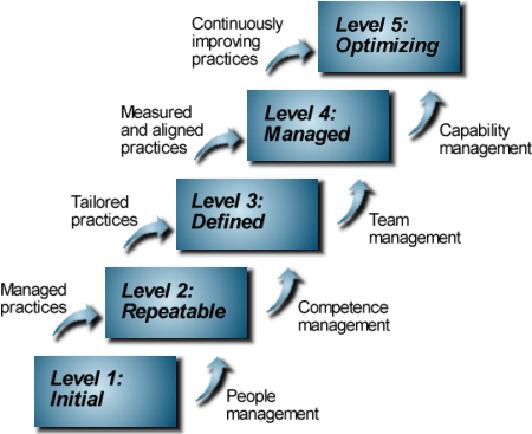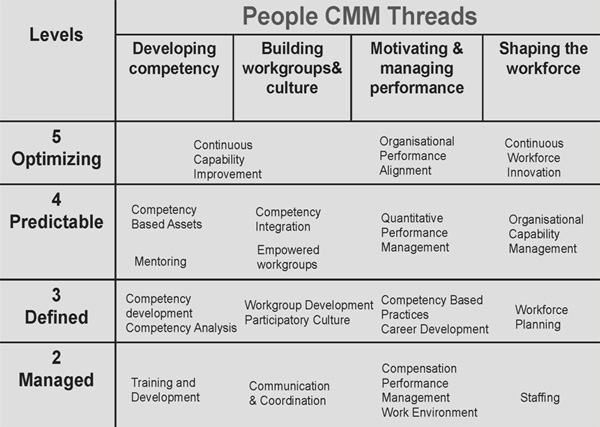People Capability Maturity Model (PCMM) is a maturity framework that focuses on continuously improving the management and development of the human assets of a software or information systems organization. PCMM can be perceived as the application of the principles of Capability Maturity Model to human assets of a software organization. It describes an evolutionary improvement path from ad hoc, inconsistently performed practices, to a mature, disciplined, and continuously improving development of the knowledge, skills, and motivation of the workforce. Although the focus in People CMM is on software or information system organizations, the processes and practices are applicable for any organization that aims to improve the capability of its workforce. PCMM will be guiding and effective particularly for organizations whose core processes are knowledge intensive.
The primary objective of the People Capability Maturity Model is to improve the capability of the entire workforce. This can be defined as the level of knowledge, skills, and process abilities available for performing an organization’s current and future business activities.
10 Principles of People Capability Maturity Model (PCMM)
The People Capability Maturity Model describes an evolutionary improvement path from ad hoc, inconsistently performed workforce practices, to a mature infrastructure of practices for continuously elevating workforce capability. The philosophy implicit the PCMM can be summarized in ten principles.
- In mature organizations, workforce capability is directly related to business performance.
- Workforce capability is a competitive issue and a source of strategic advantage.
- Workforce capability must be defined in relation to the organization’s strategic business objectives.
- Knowledge-intense work shifts the focus from job elements to workforce competencies.
- Capability can be measured and improved at multiple levels, including individuals, workgroups, workforce competencies, and the organization.
- An organization should invest in improving the capability of those workforce competencies that are critical to its core competency as a business.
- Operational management is responsible for the capability of the workforce.
- The improvement of workforce capability can be pursued as a process composed from proven practices and procedures.
- The organization is responsible for providing improvement opportunities, while individuals are responsible for taking advantage of them.
- Since technologies and organizational forms evolve rapidly, organizations must continually evolve their workforce practices and develop new workforce competencies.
The People Capability Maturity Model (People CMM) is a roadmap for implementing workforce practices that continuously improve the capability of an organization’s workforce. Since an organization cannot implement all of the best workforce practices in an afternoon, the People CMM introduces them in stages. Each progressive level of the People CMM produces a unique transformation in the organization’s culture by equipping it with more powerful practices for attracting, developing, organizing, motivating, and retaining its workforce. Thus, the People CMM establishes an integrated system of workforce practices that matures through increasing alignment with the organization’s business objectives, performance, and changing needs.
Although the People CMM has been designed primarily for application in knowledge intense organizations, with appropriate tailoring it can be applied in almost any organizational setting. The People CMM’s primary objective is to improve the capability of the workforce. Workforce capability can be defined as the level of knowledge, skills, and process abilities available for performing an organization’s business activities.
People Capability Maturity Model (PCMM) Levels
The People Capability Maturity Model consists of five maturity levels. Each maturity level is an evolutionary plateau at which one or more domains of the organization’s processes are transformed to achieve a new level of organizational capability. The five levels of People CMM are defined as follows:
- At PCMM Level 1, an organization has no consistent way of performing workforce practices. Most workforce practices are applied without analysis of impact.
- At PCMM Level 2, organizations establish a foundation on which they deploy common workforce practices across the organization. The goal of Level 2 is to have managers take responsibility for managing and developing their people. For example, the first benefit an organization experiences as it achieves Level 2 is a reduction in voluntary turnover. The turnover costs that are avoided by improved workforce retention more than pay for the improvement costs associated with achieving Level 2.
- At PCMM Level 3, the organization identifies and develops workforce competencies and aligns workforce and work group competencies with business strategies and objectives. For example, the workforce practices that were implemented at Level 2 are now standardized and adapted to encourage and reward growth in the organization’s workforce competencies.
- At PCMM Level 4, the organization empowers and integrates workforce competencies and manages performance quantitatively. For example, the organization is able to predict its capability for performing work because it can quantify the capability of its workforce and of the competency-based processes they use in performing their assignments.
- At PCMM Level 5, the organization continuously improves and aligns personal, work-group, and organizational capability. For example, at Maturity Level 5, organizations treat continuous improvement as an orderly business process to be performed in an orderly way on a regular basis.
The People Capability Maturity Model was designed initially for knowledge-intense organizations and workforce management processes. However, it can be applied in almost any organizational setting, either as a guide in implementing workforce improvement activities or as a vehicle for assessing workforce practices.
Download Presentation: PCMM
External Links about PCMM:
- The Process Audit (Harvard Business Review)
- Why is People Capability Maturity Model Necessary?

